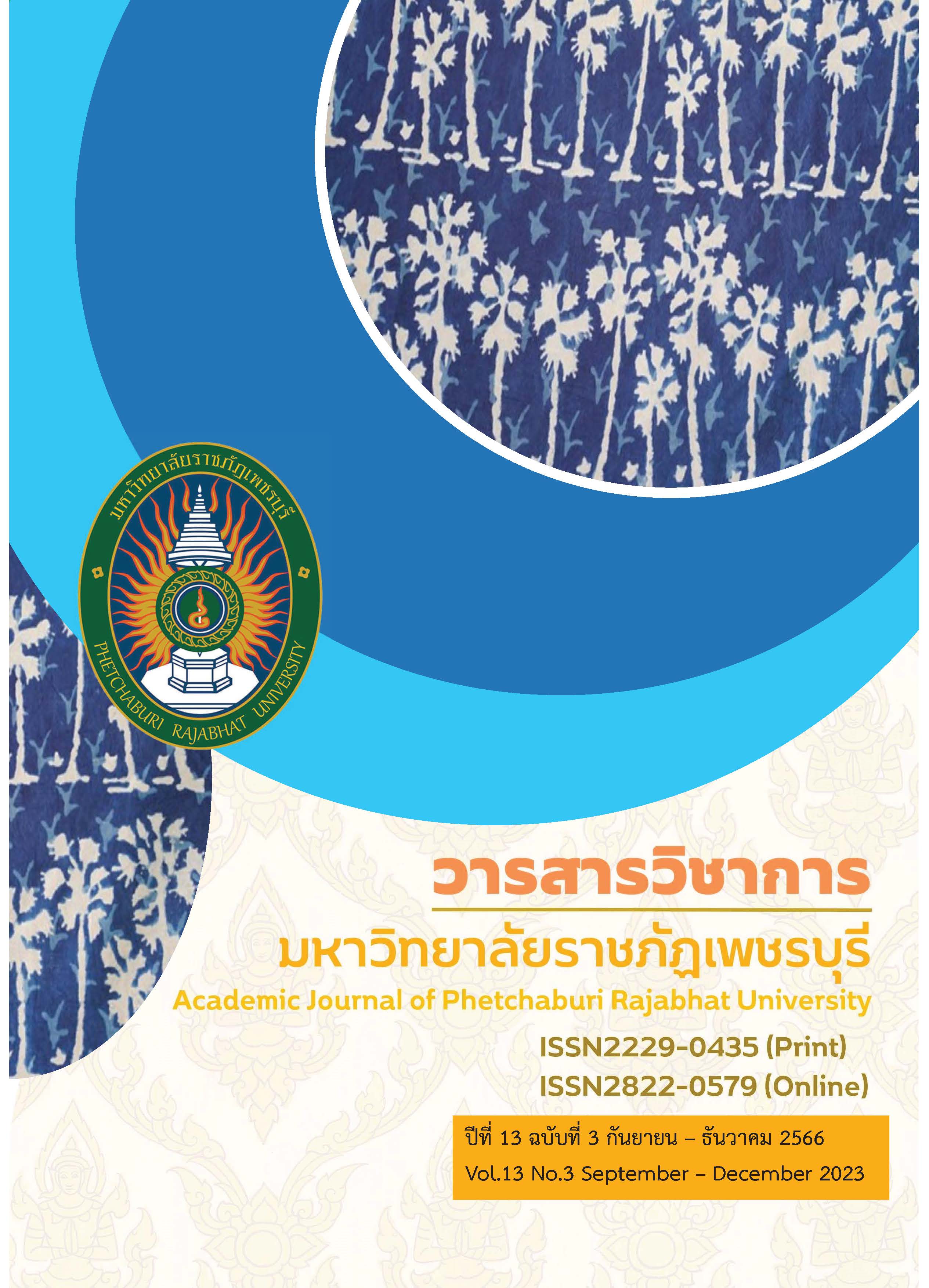การพัฒนาชิ้นส่วนร่างกายมนุษย์จำลอง เพื่อส่งเสริมทักษะการทำหัตถการ ทางศัลยศาสตร์พื้นฐานของนักศึกษาพยาบาล
Main Article Content
บทคัดย่อ
การพัฒนาสิ่งประดิษฐ์ครั้งนี้มีวัตถุประสงค์เพื่อ 1) พัฒนาชิ้นส่วนร่างกายมนุษย์จำลองในการส่งเสริมการเรียนการสอนรายวิชาปฏิบัติการรักษาพยาบาลขั้นต้นเกี่ยวกับการทำหัตถการทางศัลยศาสตร์พื้นฐานของนักศึกษาพยาบาลภายใต้กระบวนการคิดเชิงออกแบบ (Design thinking) และ 2) ประเมินความพึงพอใจต่อการใช้งานของสิ่งประดิษฐ์ที่พัฒนาขึ้น โดยใช้แบบสอบถามที่ผู้วิจัยพัฒนาขึ้นด้วยมาตรวัดประมาณค่า (Rating scale) จำนวน 8 ข้อคำถาม การวิเคราะห์ข้อมูลเชิงปริมาณใช้สถิติเชิงพรรณนา ได้แก่ จำนวน ร้อยละ ค่าเฉลี่ย และ
ส่วนเบี่ยงเบนมาตรฐาน ในขณะที่ข้อมูลเชิงคุณภาพวิเคราะห์โดยใช้วิธีการวิเคราะห์เนื้อหา (Content analysis) กลุ่มตัวอย่างถูกสุ่มเลือก
แบบเจาะจงจากนักศึกษาพยาบาลศาสตรบัณฑิตชั้นปีที่ 4 จำนวน 29 คน ผลการศึกษาพบว่า กลุ่มตัวอย่างมีความพึงพอใจต่อแบบจำลองชิ้นส่วนเพื่อการเย็บแผล และการถอดเล็บในภาพรวมอยู่ในระดับมากที่สุดร้อยละ 79.31% (Mean=4.79, S.D.=0.41) และร้อยละ 65.52% (Mean=4.66, S.D.=0.48) ตามลำดับ แม้ว่าสิ่งประดิษฐ์จำลองที่พัฒนาขึ้นจะช่วยส่งเสริมการเรียนรู้ และความมั่นใจในการปฏิบัติหัตถการทางศัลยศาสตร์พื้นฐานได้จริง แต่ลักษณะความเสมือนจริง ความคงทนต่อการใช้งาน และความพอเพียงของจำนวนอุปกรณ์/สิ่งประดิษฐ์ ยังเป็นสิ่งที่ควรต้องปรับปรุงและพัฒนาต่อยอดในอนาคต
Article Details

อนุญาตภายใต้เงื่อนไข Creative Commons Attribution-NonCommercial-NoDerivatives 4.0 International License.
บทความนี้ยังไม่เคยลงตีพิมพ์ในวารสารใดมาก่อน และไม่อยู่ระหว่างการพิจารณาของวารสารอื่น
บทความที่ลงพิมพ์เป็นข้อคิดเห็น/แนวคิด/ทัศนคติของผู้เขียนเท่านั้น หากเกิดผลทางกฎหมายใดๆที่อาจ
เกิดขึ้นจากบทความนี้ ผู้เขียนจะเป็นผู้รับผิดชอบ และบทความนี้เป็นลิขสิทธิ์ของวารสารเท่านั้น
เอกสารอ้างอิง
Boromarajonani College of Nursing Ratchaburi. Programme specification of Bachelor of Nursing Science (revised programme, 2018). Thailand; 2018. (in Thai)
Khonboon R, Panthonglang W, Choojan S. Instructional Model for Nursing Students in “New Normal.” J Vongchavalitkul Univ. 2022; 35(1):1–12. (in Thai)
Rodkaew P, Dulyakaseam U, Kanjanaaree S. State of Online Learning During Pandemic of Corona Virus 2019 (COVID-19) of Boromarajonani Nakhon Si Thammarat, College of Nursing. J MCU Nakhondhat. 2022; 9(2):125–41. (in Thai)
Madsgaard A, Røykenes K, Smith‑Strøm H, Kvernenes M. The afective component of learning in simulation-based education – facilitators’ strategies to establish psychological safety and accommodate nursing students’ emotions. BMC Nurs. 2022; 21(91):1–10.
Lugo RG, Hjelmeland I, Hansen MT, Haug E, Sütterlin S, Grønlien HK. Impact of Initial Emotional States and Self-Efficacy Changes on Nursing Students’ Practical Skills Performance in Simulation-Based Education. Nurs Rep. 2021; 11(2): 267–78.
Habibli T, Ghezeljeh TN, Haghani S. The effect of simulation-based education on nursing students’ knowledge and performance of adult basic cardiopulmonary resuscitation: A randomized clinical trial. Nurs Pract Today [Internet]. 2020; 7(2): 87–96. Available from: http://npt.tums.ac.ir
AlBalawi I, Alqahtani JS, Ghamdi SS Al, Aldhahir AM, Alnasser M, Alqahtani AS, et al. Health Sciences Students’ Attitude, Perception, and Experience of Using Educational Simulation in Saudi Arabia: A Cross-Sectional Study. Nurs Rep. 2022; 12: 620–8.
Eiamla-or P, Takan S, Wongsasung J, Ratanapariyanuch S. Development of the Suturing Wound Model for Nursing Students. J Heal Nurs Res. 2021; 37(3): 304–18.
Beaird G, Geist M, Lewis EJ. Design Thinking: Opportunities for Application in Nursing Education. Nurse Educ Today. 2018; 64: 115–8.
Roddy L, Polfuss M. Employing design thinking methods in nursing to improve patient outcomes. Vol. 55, Nursing Forum. 2020. p. 553–8.
Yamane T. Statistics: An Introductory Analysis, 2nd Ed., New York: Harper and Row. J Agric Ext Rural Dev. 1967;
Lewrick M, Link P, Leifer L. The Design Thinking Playbook. United State: John Wiley & Sons, Inc.; 2018. 352 p.
Supphaphon P. Introduction of Thermoplastic Rubber. Kasetsart Eng J. 1998; 12(36): 5–11. (in Thai)
Sae-ouy P. Rubber: type, qualification and utilisation. Thailand: National Metal and Materials Technology Center; 2004. 125 p. (in Thai)
Todd RW. Analyzing and Interpreting Rating Scale Data from Questionnaires. REFLections [Internet]. 2018; 14: 69–76. Available from: https://so05.tci-thaijo.org/index.php/reflections/article/view/114230
Saengloetuthai J. Quality of Research Instrument. J Res Curric Dev. 2018; 7(1):1–15. (in Thai)
Burnett B, Evans D. Designing your life. Sripattanasakul M, editor. Thailand: Book scape co,Ltd.; 2018. 296 p.
Pol‑Castañeda S, Carrero‑Planells A, Moreno‑Mulet C. Use of simulation to improve nursing students’ medication administration competence: a mixed‑method study. BMC Nurs. 2022;21(117):1–10.


